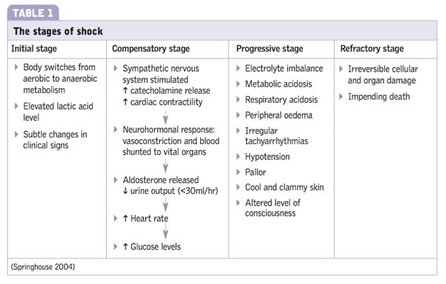The emergency department nurse is assessing a patient who is in the compensatory stage of hypovolemic shock. Which manifestations does the nurse expect? Select all that apply.
Elevated heart rate.
Elevated respiratory rate.
Decreased pulse rate.
Decrease systolic blood pressure.
Decreased urine output.
Bilateral crackles in the lung bases.
Correct Answer : A,B,D,E
These manifestations occur as compensatory mechanisms in response to decreased blood volume and compromised tissue perfusion. The body attempts to compensate for the inadequate circulating volume by increasing heart rate (A) and respiratory rate (B) to enhance oxygen delivery.
D. The decreased systolic blood pressure (D) is a result of decreased cardiac output and vasoconstriction in an attempt to maintain perfusion to vital organs.
E. The decreased urine output (E) is a result of decreased renal perfusion due to decreased blood volume.
C. Decreased pulse rate in (option C) is incorrect because it is not typically seen in the compensatory stage of hypovolemic shock. The body tries to increase heart rate to maintain cardiac output and compensate for the decreased blood volume.
F. Bilateral crackles in (option F) is incorrect because the lung bases are more commonly associated with conditions such as pulmonary edema or fluid overload, rather than the compensatory stage of hypovolemic shock.
It's important to note that the manifestations of shock can vary depending on individual patient factors and the underlying cause of shock. Therefore, a comprehensive assessment and clinical judgment are necessary to fully evaluate the patient's condition.
Nursing Test Bank
Naxlex Comprehensive Predictor Exams
Related Questions
Correct Answer is B
Explanation
Lactate is a by-product of anaerobic metabolism that accumulates when there is insufficient oxygen supply to meet cellular metabolic demands. In the context of severe tissue hypoxia, such as in septic shock, the body may resort to anaerobic metabolism, leading to increased lactate production and elevated lactate levels in the blood.
Elevated lactate levels, typically above 4.0 mmol/L, are indicative of tissue hypoxia and inadequate oxygenation at the cellular level. Higher lactate levels, such as 9.0 mmol/L, suggest more severe tissue hypoxia and increased anaerobic metabolism.
A. Partial thromboplastin time (PTT) 64 seconds in (option A) is incorrect because: PTT is a laboratory test that evaluates the intrinsic pathway of the coagulation cascade. While coagulation abnormalities may occur in septic shock, PTT alone does not specifically indicate severe tissue hypoxia.
C. Potassium 2.8 mEq/L (2.8 mmol/L) (option C) is incorrect because Low potassium levels (hypokalemia) can be a concern in septic shock, but it does not directly indicate severe tissue hypoxia.
D. PaCO2 58 mm Hg in (option D) is incorrect because: PaCO2 refers to the partial pressure of carbon dioxide in arterial blood and is a measure of the respiratory status. While an elevated PaCO2 can be a sign of respiratory acidosis, it is not specific to severe tissue hypoxia.
Therefore, in a critically ill patient with septic shock, an elevated lactate level, such as 9.0 mmol/L, indicates severe tissue hypoxia and inadequate oxygenation at the cellular level
Correct Answer is D
Explanation
In the compensatory stage of shock, the body initiates various mechanisms to maintain perfusion to vital organs and restore homeostasis. Activation of the renin-angiotensin system is one of the compensatory responses. The decreased blood flow and oxygen delivery to the kidneys stimulate the release of renin from the kidneys. Renin acts on angiotensinogen, converting it into angiotensin I, which is further converted to angiotensin II by the action of angiotensin-converting enzyme (ACE). Angiotensin II is a potent vasoconstrictor and also stimulates the release of aldosterone, leading to sodium and water retention. These mechanisms aim to increase blood pressure and cardiac output and restore fluid balance.
A. The initial stage of shock in (option A) is incorrect because it is characterized by inadequate tissue perfusion and the activation of various compensatory mechanisms, including the release of stress hormones. However, the renin-angiotensin system is not specifically mentioned as activated in this stage.
B. The progressive stage of shock in (option B) is incorrect because it occurs when compensatory mechanisms fail to maintain adequate perfusion, leading to worsening hypoperfusion and organ dysfunction. The renin-angiotensin system continues to be activated during this stage, but it is primarily associated with the compensatory stage.
C. The refractory stage of shock in (option C) is incorrect because it is the stage of severe and prolonged hypoperfusion, where organ failure becomes irreversible. The renin-angiotensin system may still be activated, but it is not the primary focus of this stage.
Therefore, the activation of the renin-angiotensin system occurs during the compensatory stage of shock.

Whether you are a student looking to ace your exams or a practicing nurse seeking to enhance your expertise , our nursing education contents will empower you with the confidence and competence to make a difference in the lives of patients and become a respected leader in the healthcare field.
Visit Naxlex, invest in your future and unlock endless possibilities with our unparalleled nursing education contents today
Report Wrong Answer on the Current Question
Do you disagree with the answer? If yes, what is your expected answer? Explain.
Kindly be descriptive with the issue you are facing.
